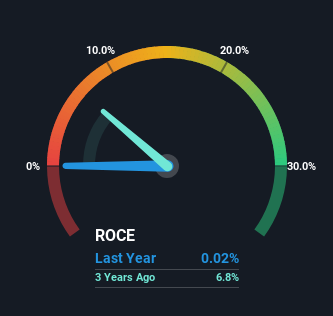Some Investors May Be Worried About Caesarstone's (NASDAQ:CSTE) Returns On Capital
When researching a stock for investment, what can tell us that the company is in decline? When we see a declining return on capital employed (ROCE) in conjunction with a declining base of capital employed, that's often how a mature business shows signs of aging. Trends like this ultimately mean the business is reducing its investments and also earning less on what it has invested. And from a first read, things don't look too good at Caesarstone (NASDAQ:CSTE), so let's see why.
Understanding Return On Capital Employed (ROCE)
For those that aren't sure what ROCE is, it measures the amount of pre-tax profits a company can generate from the capital employed in its business. To calculate this metric for Caesarstone, this is the formula:
Return on Capital Employed = Earnings Before Interest and Tax (EBIT) ÷ (Total Assets - Current Liabilities)
0.00018 = US$102k ÷ (US$710m - US$139m) (Based on the trailing twelve months to March 2023).
Therefore, Caesarstone has an ROCE of 0.02%. Ultimately, that's a low return and it under-performs the Building industry average of 15%.
View our latest analysis for Caesarstone
In the above chart we have measured Caesarstone's prior ROCE against its prior performance, but the future is arguably more important. If you'd like, you can check out the forecasts from the analysts covering Caesarstone here for free.
What Does the ROCE Trend For Caesarstone Tell Us?
In terms of Caesarstone's historical ROCE movements, the trend doesn't inspire confidence. About five years ago, returns on capital were 10%, however they're now substantially lower than that as we saw above. On top of that, it's worth noting that the amount of capital employed within the business has remained relatively steady. This combination can be indicative of a mature business that still has areas to deploy capital, but the returns received aren't as high due potentially to new competition or smaller margins. If these trends continue, we wouldn't expect Caesarstone to turn into a multi-bagger.
What We Can Learn From Caesarstone's ROCE
In summary, it's unfortunate that Caesarstone is generating lower returns from the same amount of capital. Investors haven't taken kindly to these developments, since the stock has declined 63% from where it was five years ago. With underlying trends that aren't great in these areas, we'd consider looking elsewhere.
If you're still interested in Caesarstone it's worth checking out our FREE intrinsic value approximation to see if it's trading at an attractive price in other respects.
For those who like to invest in solid companies, check out this free list of companies with solid balance sheets and high returns on equity.
Have feedback on this article? Concerned about the content? Get in touch with us directly. Alternatively, email editorial-team (at) simplywallst.com.
This article by Simply Wall St is general in nature. We provide commentary based on historical data and analyst forecasts only using an unbiased methodology and our articles are not intended to be financial advice. It does not constitute a recommendation to buy or sell any stock, and does not take account of your objectives, or your financial situation. We aim to bring you long-term focused analysis driven by fundamental data. Note that our analysis may not factor in the latest price-sensitive company announcements or qualitative material. Simply Wall St has no position in any stocks mentioned.
Join A Paid User Research Session
You’ll receive a US$30 Amazon Gift card for 1 hour of your time while helping us build better investing tools for the individual investors like yourself. Sign up here

